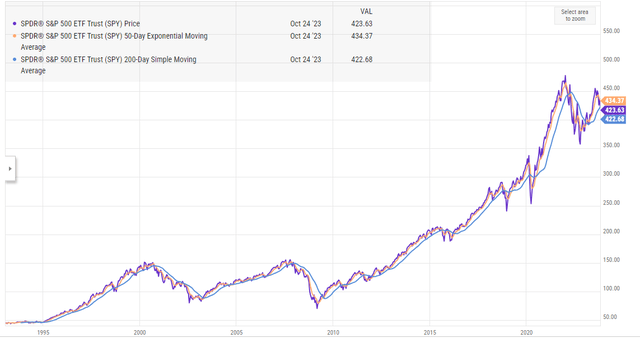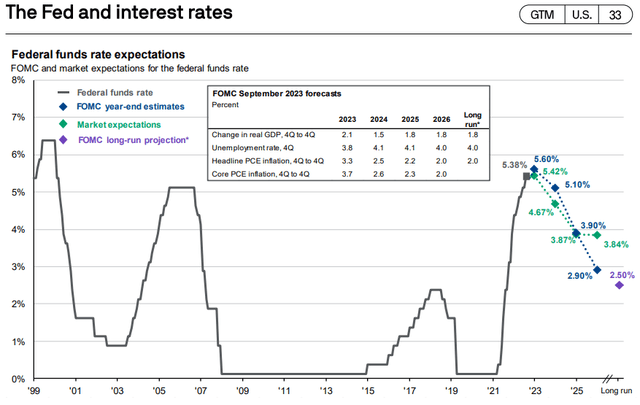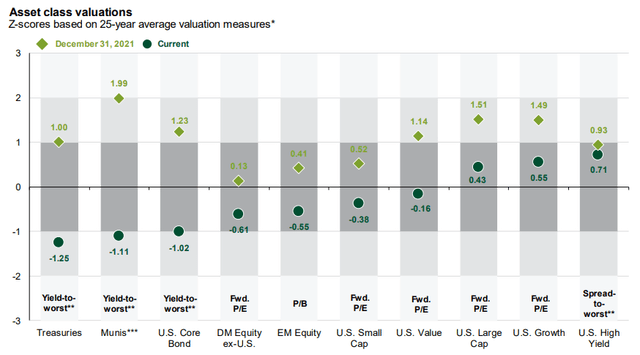Market commentators, including some writers on Seeking Alpha, are stepping up quantity and intensity of crash predictions. I understand analysts like to point at concerning 1) signals in technical analysis, 2) events in the Middle East and broader global geopolitical tensions, 3) inflation and interest rate pressure and, 4) general overvaluation of the broader stock market. While I am not educated in the art of being a bear to assess the full sophistication of arguments, I simply don’t see the severity of any of these risks. In this article I explain.
Ignore Technical Analysis If You Want To Make Money With Stocks
Technical analysis is a methodology that involves studying historical stock price and volume data, with the goal of predicting future price movements. With that said, a look at the S&P 500 chart reveals a concerning situation across multiple timeframes. The monthly chart shows that the S&P 500 is currently trading below or close to 4238. The next support in this timeframe is not expected before 4100, approximately. On the weekly chart, a bearish engulfing pattern and a broken channel indicate the likelihood of new lows. On the daily chart, we see the price action breaking below the crucial 50 day moving average, indicating a bearish shift in sentiment.
Ignore technical analysis if you want to make money with stocks. That’s right, go ahead, close those charts, wave goodbye to those oscillators, and toss those Fibonacci lines into the trash. As I see it (and you may of course agree), technical analysis doesn’t predict future events or factors that may affect stock prices, such as economic developments or company performance. I have a feeling that technical analysis predicted 78 out of the past 3 crashes. Moreover, technical interpretation of charts and patterns can vary between analysts, leading to very subjective judgments. Whatever I argued above on a monthly, weekly and daily basis is likely not be echoed by another student of charts.
That said, there is one technical insight that I accept — an insight with decades of data: The S&P 500 is showing a consistent uptrend, with exponential growth skew. It is also noteworthy how nicely the moving averages confirm the trend.
Ycharts
Events In The Middle East Won’t Crash The Market
As a key argument for a stock market crash, market commentators like to point to the risk brought about by the recent outbreak of fighting in Israel and Hamas. Reasons for concern include potential for geopolitical tensions, as well as a probable oil price rally on supply chain disruptions. However, most of the concerns relate to a broader conflict in the Middle East, beyond Israel and Hamas, that engages the U.S and Iran in a proxy war. As I see it, this consideration is more of a tail-risk, rather than reasonable future projections. And pre-maturely responding to this with a stock market crash would be nothing short of “stupid”.
Moreover, while the conflict in the Middle East is very unfortunate, from a market perspective there is little argument for concern. In a previous article, I have analysed what happened to U.S. equities during major Middle East conflicts, covering 1) the Six-Day War of 1967; 2) the Gulf War, 1990-1991; 3) the Iraq War, 2003-2011; and 4) the Arab Spring, 2010-2011. The takeaway was quite consistent; Stocks are do not show a tendency to go bearish on geopolitical tensions in the Middle East. In fact, following an initial period of elevated market volatility, U.S. equities like to make new highs within 12-18 months from the conflict outbreak.
Inflation and Interest Rates Are Old News
Markets are forward looking. Markets are rarely interested in trends that happened in the past. What is interesting to markets is the rate of change. And as I observe it, the rate of change in both inflation and interest rates is favorable. Latest data points on core inflation show the CPI trending towards 3% YoY growth. Meanwhile, wage growth is dropping towards the 50-year historical average of 4% YoY. These easing pressure points on pricing contribute to a favorable rates outlook, as mapped by JP Morgan (JPM).
JP Morgan Economic Research
With this context, investors should consider that if the aggressive, unexpected past hiking path in interest rates didn’t crash the markets (although it did in 2021), then the next leg in the path forward, namely rates going down, won’t do it either.
Admittedly, even though inflationary headwinds and rates pressure are easing, the high implied time value of money is still a concern to many investors. However, investors concern on rates will likely be a headwind to upside; it won’t be a catalyst for downside. And what I am saying in this article is not that we are rallying, but that we ain’t crashing.
General Overvaluation Of The Broader Stock Market
Finally, investors are concerned about the valuation of the S&P 500, citing an implied 2024 P/E of close to 18x. But I have a very hard time buying the valuation story. First, I point out that on an aggregate level, the valuation of U.S. equities is relatively in line with historical metrics.
In that context, the graph below provides a comparative assessment of major asset classes and styles in relation to their historical averages over a twenty-five-year period, expressed as z-scores. Z-scores are a statistical metric indicating the number of standard deviations a data point deviates from the mean of a distribution. This calculation is represented as:
Z = (X – μ) / σ
Here, Z signifies the z-score, X represents the individual data point, μ denotes the mean of the dataset, and σ signifies the standard deviation of the dataset. A low z-score suggests that the data point is below the mean, and the magnitude of the z-score quantifies the extent to which the data point deviates from the mean in terms of standard deviations.
As you see, the stocks appear to be reasonably priced – with growth trading at a slight premium being offset by a discount in small cap and value.
JP Morgan Economic Research
Related to valuation, market commentators also like to point out that the top-heavy S&P 500 index, comprised of the Magnificent Seven, renders the market vulnerable to a rerating. However, I think this argument is quite ludicrous. Investors should note the most recent earnings reports of the Magnificent Seven.
- Microsoft Q3: +24% YoY
- Google Q3: +25% YoY
- Tesla Q3: -52% YoY
- Meta Platforms Q3: +143% YoY
- Apple Q3: outstanding, but analysts see +11% YoY
- Nvidia – the company has not yet reported Q3, but the latest report, Q2, was eyewatering, with +1,263% YoY. Q3 should likely deliver similarly YoY performance.
- Amazon Q3: +348% YoY
For the group, weighted by dollar value, operating earnings are up more than 20% YoY, outpacing the gain of the 11% gain of the S&P 500. The strong earnings growth should also arguments about the inflation and rates headwind argued in the previous section of this article. Against such a backdrop, how can anybody argue that U.S. equities are setting up for a crash?
A Note On Risks
Certainly, investing in equities comes with its inherent risks that should not be underestimated, especially considering the persistent economic challenges. It’s crucial to keep the following four key risk factors in mind: First, there is just a general level of noise and market volatility as equities are prone to sentiment-induced price swings; Second, there remains a notable level of economic Uncertainty with estimates for a U.S. recession in 2024 varying between 25-40% depending on the analyst. Although a recession will likely not cause a crash, a recession may pressure equities’ valuation on earnings headwinds; Third, I see sector-specific vulnerabilities that can impact the performance of certain industries within the S&P 500 more than other industries; Finally, there is time risk, as the realization of returns from S&P 500 investments typically requires a long-term commitment.
Overall, I believe quite strongly in my assessment that technical analysis is little helpful, that the Middle East conflict is not a crash catalyst, that inflation and interest rates have peaked, and that stocks are not expensive. I may be wrong, however, in my assessment of how other market participants view these pressure points. Specifically, the stock market remains a sentiment-driven collective of people; and thus, it is worth pointing out that sentiment is always shaky, and prone to react excessively to the downside (but also on the upside). Investors should keep this in mind.
Personally, I will closely watch inflation and interest rate dynamics. Any surprising, strong uptick in CPI numbers would definitely be alarming — and lead to a revision in my thesis.
Conclusion
Despite a growing chorus of predictions about an impending stock market crash, there are more compelling reasons to view these concerns with skepticism. The arguments put forth by some analysts are centered on technical analysis, geopolitical tensions in the Middle East, inflation, interest rates, and general overvaluation of the market. However, a closer look reveals that these risks may not be as severe as they appear. First, technical analysis, often used to predict market movements, is subjective and has a mixed track record. The consistent uptrend in the S&P 500 suggests that, despite short-term fluctuations, the long-term trajectory remains positive; Second, geopolitical tensions in the Middle East historically haven’t led to prolonged market downturns. In fact, U.S. equities have typically rebounded within 12-18 months after such conflicts; Third, concerns about inflation and interest rates may be easing, with favorable trends in core inflation and wage growth. Even if rates rise, they are unlikely to trigger a market crash; Fourth, the argument of general overvaluation in the stock market is mitigated by historical metrics, and the top-heavy S&P 500 is still supported by strong earnings growth among the “Magnificent Seven” tech companies.
To conclude, I continue to like investing in stocks. And I am knowingly and happily betting against anybody who is taking a bearish view on markets. Thank you for reading. Looking forward to your comments.
Read the full article here



